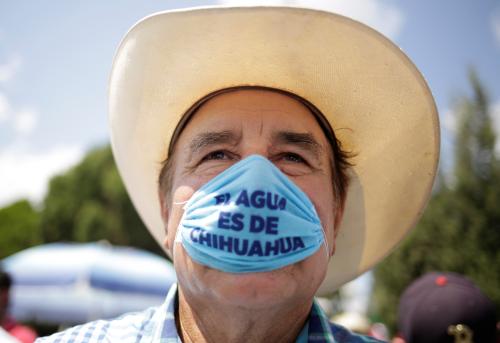After Trump, the United States has a long and difficult way ahead to heal its institutions, political divisions, and people, writes Vanda Felbab-Brown. This piece originally appeared in La Reforma’s Mexico Today.
Since Tuesday night, the United States has waited with bated breath for the results of the 2020 presidential and congressional elections. Throughout the country, there is much concern that the basic rule-of-law values and institutions of our country are at stake as in this year’s election contest between the incumbent President Donald Trump and former Vice President Joseph Biden. Shockingly, this anxiety extends to uncertainty over whether President Trump, who is on the brink of losing, will accept the loss within the parameters of legality which are the essence of the U.S. electoral system.
The United States is deeply polarized: Many of the wounds and chasms originating in the early 1990s of the Newt Gingrich era who, first as a U.S. House of Representatives Republican Minority Whip (1989-1995) and later as Speaker of the House (1995-1999), threw bipartisanship overboard on even core national policy issues and sacrosanct procedural elements, such as government budgets, and instead pushed the Republican Party away from attempting to appeal to middle centrists voters and to catering to the party fringes.
Other sources of the polarization are deeply structural: Various segments of U.S. society feel left out and behind, and increasingly unable to reach the American Dream of achieving a good life and social mobility through hard work in a free country. The aggrieved include African Americans still suffering the effects of slavery, exclusion, Jim Crow laws, and racism. They also include white lower-middle class Americans who have lost hope (Their parents and grandparents had realized the American Dream by working in expanding factories; but they themselves have not been able to keep up with automation, requirements for higher-skills, and globalization, as assembly-line types of jobs moved abroad.) For three decades now, those with displaced occupational skills have been bereft of adequate help, and are increasingly frustrated and angry.
Donald Trump tapped into some of these frustrations and poured hatred, racism, scape-goating, and anger onto those wounds. With histrionics, melodrama, poisonous language, and screams, he seized the anger and frustration and cultivated an impassioned following. Meanwhile, highly religious communities like U.S. evangelicals voted for him while holding their noses — forgiving his vulgarity, disrespect for women, immorality, and disrespect for rule of law — for the sake of his being able to stuff U.S. courts with highly conservative judges advancing their agenda. And just before the 2020 elections, Trump delivered the ultimate prize to them: the U.S. Senate’s ramming through the appointment of conservative judge, Amy Barrett, to the U.S. Supreme Court, locking in place a very conservative court for perhaps decades to come.
Over the past four years, Trump’s policies have ranged from the vacuous but still very costly (a trade war with China), to the legally precarious and thrown out by courts (moves against sanctuary cities), to snake-oil false medicines jeopardizing the deaths of hundreds of thousands of Americans (his dismissal of the coronavirus pandemic and behavioral failures like leading his followers not to wear face masks), to outright evil and barbaric (separating migrant children from their parents). Other than partially building a pointless, expensive bollard wall along the border with Mexico, an egregious waste of a money and a source of atrocious environmental destruction, Trump has delivered very little to his mass followers. Their lives have become emotionally hyped and filled with hatred, but not economically or socially better.
And egregiously, his administration has served narrow vested interests groups in unleashing dangerous deregulation entailing massive risks to the financial system, public health, and the environment. Indeed, systematically throughout his presidency, Trump has sought to dismantle, weaken, undermine, or pervert one government institution after another – from the Department of State, to the Federal Bureau of Investigation, Department of Justice, U.S. intelligence agencies, the Environmental Protection Agency, the U.S. Fish and Wildlife Service, and many others.
But still Trump retains a significant following, despite his vulgar behavior and disastrous policies: Although as of the vote count of 9am Friday morning, some 74 million Americans had voted for Biden, almost 70 million Americans had voted for him. Those numbers highlight two elements: The first is the large voter turnout: The largest since 1900, the turnout shows how much the American people felt to be at stake in this election.
The second element brought to light by those numbers is how polarized and split down the middle the United States remains and will be at the beginning of the very likely upcoming Biden administration. The political, social, ideological, and emotional chasms now run very deep and painful.
Hiding among those razor-sharp cleavages are surprises as well: Despite Trump’s brutal racist anti-immigration policies, apparently as many as 36 percent of Latino voters voted for Trump (not just the traditional Republican enclaves of people of Cuban and Venezuelan origin, but also Mexican Americans in Texas and Arizona. The motivations vary: from conservative sentiments against abortion, to the strong role of Evangelical religion, to opposition to proposals to defund police departments that has been advocated embraced by some African American and police reform groups.
Similarly, although American Muslims voted in large numbers and 70 percent voted for Biden, 17 percent voted for Trump – despite this undisguised and disgusting Islamophobia. With all the pain and polarization in the country, one sign of the health of democracy in our country is that the political cleavages exhibited in the election cut across ethnic and religious lines.
The basic polarization, however, will make policy making and implementation very difficult for the Biden administration. Achieving compromise and consensus on many, if not most issues, will be painstakingly difficult — not the least on the critical issue of how to handle the out-of-control COVID-19 pandemic. On November 3, the election day, the United States registered 92,660 new COVID-19 cases; on November 4: 107,872; on November 5: 121, 504 – each day a tragic new record of infection, with records of death soon to follow. So many of these deaths are unnecessary, being the result of Trump’s ignorance of and willful denigration of the legitimacy and credibility of science –for for the most selfish of motives – his own political gain.
Trump’s disastrous presidency of lies, corruption, disregard for the rule of law, unbound selfishness, hatred, and systematic jeopardizing of U.S. core national interests may well be capped by an equally disastrous departure from the office.
His campaign has already mounted legal challenges in multiple U.S. states, demanding vote recounts and alleging malfeasance and fraud. Trump has a perfect right to demand recounts. But his despicable allegations for fraud leveled against Joe Biden and the Democratic Party are baseless and egregious.
On November 5, as it became increasingly clear that he would not be reelected, Trump delivered a stomach-churning, preposterous, lie-ridden speech claiming fraud. Even by Trump’s own standards of revolting prevarication, demagoguery, insanity, and hatred filled speeches, last night’s sank to a new low. By veering between deranged ramblings of a psychopathic mind and venomous lies, it sullied free and fair elections in our country and demeaned its very institutional foundations and principles. The speech requires resolute and resounding condemnation from all, including Republican politicians. Some have done so.
Shocking as it is to say about our country in the 21st century, the post-election transition period may yet be characterized by violence if Trump refuses to accept the verdict of the legal processes that will very likely confirm he lost. Self-styled armed groups have become dangerously visible in our country. Many of those supporting him have sought to intimidate Democratic politicians as well as the public, while Trump egregiously has egged them on. Some have planned terrorist attacks against Trump’s political rivals. Other opponents and critics of Trump, often as a result of his words, have faced death threats, in a script out of an authoritarian country, not what should be the beacon of democracy in the world.
Yet when the smoke over the elections clears, despite the poison and polarization, it will be shown that the electoral procedures ultimately held up and proved resilient, sounder than the politics around them. The vote counting will be shown to have been slow but unwaveringly scrupulous, honest and diligent, with minimal manipulation and corruption –unbendingly resistant to men with weapons or demagogues. State institutions administering the elections will have done so with responsibility and seriousness, the individuals recording and certifying the ballots doing so with a minimal of bias despite their political preferences and beliefs, guided by higher principles of integrity and democracy.
After Trump, the United States has a long and difficult way ahead to heal its institutions, political divisions, and people. Unlike Trump, and facing an acute crisis threatening the lives of hundreds of millions of Americans and a divided and bitter public, Joe Biden, as he promised, will need to be a president of all Americans – of those hurt by Trump, those hurt before Trump and exploited by him, and those who supported him.
But the resilience of the U.S. electoral system is a precious and strong foundation from which to start the healing.







Commentary
Op-edUS democracy rescues itself
November 9, 2020